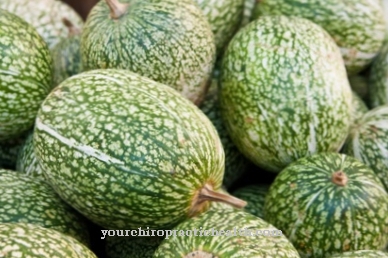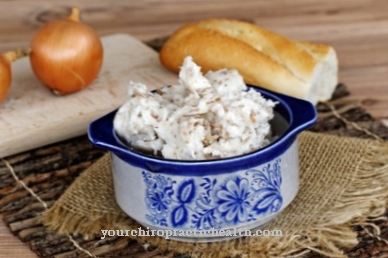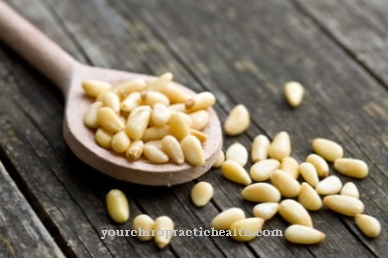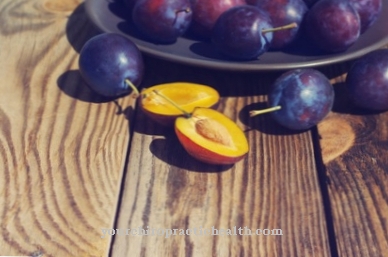The Plum, which belongs to the rose family, is a juicy, deep purple plum variety with small, elongated fruits and yellow-green to orange-colored flesh, while the plums are more rounded. In the case of plums, the stone can also be removed more easily. The stone fruit is very popular to cover sheet cakes with it.
What you should know about the plum

The plum, a very old plum variety, came to Europe over 2,000 years ago. Originally it comes from Damascus, whereby the culture of the plum can be traced back to antiquity, because the fruit has its roots in the Middle East.
It is now growing in all regions where a moderate climate is to be found, with the main growing areas of plum besides Germany being the countries of the Mediterranean Sea. Since the plum tree was cultivated in Europe, the plum has been crossed over and over again, so that numerous different varieties have emerged that differ in terms of shape, color and taste. In terms of color, the four to eight centimeters long fruits can be yellow, green to yellow, red and blue. The harvest time is from July to October, depending on the variety.
With their fruity-sweet aroma, the fruits are a comfort to the end of summer. The elongated oval plum with the typical pointed end has no furrow or seam and the firmer, juicy and pleasantly sweet and sour pulp can be easily removed from the stone compared to the plum.
Importance to health
The plum, the popular summer fruit, not only tastes very good, it is also extremely healthy because it has numerous important minerals and trace elements such as copper, potassium and zinc as well as valuable vitamins such as vitamins A, C, E and B Vitamins, thanks to which performance and concentration are improved and there is protection against diseases.
In addition, the immune system as well as the nerves are strengthened, the stress is better relieved, so that moods and depression are counteracted. The high provitamin A content is important for eyesight and healthy skin. Due to the high sorbitol content (sugar alcohol), the plum also has a digestive effect, which is even greater with dried fruits than with fresh stone fruits. The contained anthocyanins, the plant pigments, are able to bind free radicals, which damage the cells and thus cause cancer.
Thanks to the indigestible fiber in the plum, digestion is stimulated.
In the case of constipation, five to ten dry plums are soaked in the evening and eaten in the morning. The fruits contain a lot of pectin, which swells and thus softens the stool. The stone fruit also helps with loss of appetite, anemia, liver and kidney problems, gout and rheumatism. If you have a sore throat or inflammation of the gums, the leaves of the tree can be used to boil a brew to gargle with, which will provide quick relief. Thus, the plum helps with many diseases and ailments.
Ingredients & nutritional values
Plums contain many different minerals, trace elements and vitamins, for example potassium, calcium, zinc, iron, copper and boron as well as vitamins of the B group. The blue dye is one of the flavonoids and also has positive effects on the human body, because flavonoids can have an antioxidant effect and prevent cancer and cardiovascular diseases.
There is also the abundant provitamin A. Although the ripe plum tastes sweet, it can also be consumed by figure-conscious people with a clear conscience, as the fat content is almost zero.
Intolerances & allergies
The plum is generally well tolerated, but diabetics should eat them in moderation, as the stone fruit is relatively high in carbohydrates. In addition, the fruit acids can have a slight laxative effect, which is beneficial in the case of constipation. People with kidney disease sometimes report that eating the plum causes pain in the kidney area once they have eaten too much of it.
Shopping & kitchen tips
The juicy, sweet plum is available almost all year round, although it is only grown locally from July to around October. When buying, you should make sure that the stone fruit is fresh in color, has a fine fragrance and is firm.
The style approach of the plum should be plump and not have any wrinkles. If the stone fruit is harvested directly from the tree, it has a fine, whitish, waxy scent film that the fruit itself forms to protect itself from drying out. When choosing fruits in the store, this is a typical characteristic of good quality. The coating should only be washed off before consumption. It is also important to ensure that the plum does not ripen. Therefore, when you buy it, it should be well-matured, i.e. no longer greenish or hard, but also not too soft. In general, it is advisable not to store the plum for more than three to four days.
For this purpose, it should be placed in a damp cloth and stored in the vegetable compartment of the refrigerator so that it does not lose moisture. The plum can also be frozen. To do this, it is washed thoroughly, dried well, the stem removed, cut in half and pitted. Now the halved plums can be placed in a freezer bag and frozen. They thaw the most gently in a glass bowl in the refrigerator. If they are intended as a topping for a cake, the fruits can also be placed frozen on the dough and baked in this way.
Preparation tips
The plum can be used in many ways. It is possible to consume and process them raw, cooked or as dried fruit. Due to its pleasantly sweet aroma, it is often used to prepare a jam or compote or to top a cake with it. The bottom stays nice and crispy with the latter, because the fruits lose very little juice.
The stone fruit also tastes very good when processed into pancakes. Another classic are plum dumplings with vanilla sauce. But the plum is not only used for food, but also for the production of beverages, for example for schnapps, liqueurs and wines. They shouldn't be missing in the rum pot either. The fruits also go well with meat dishes. Here they are marinated in red wine, rosemary and thyme. They are also ideal for filling a roast goose or duck.
The purée from the plum is also simply delicious to refine a sauce. Regardless of whether it is canned, fried or baked, the plum can be used to conjure up wonderful desserts, cakes or other sweet dishes, but also healthy, hearty dishes.



























